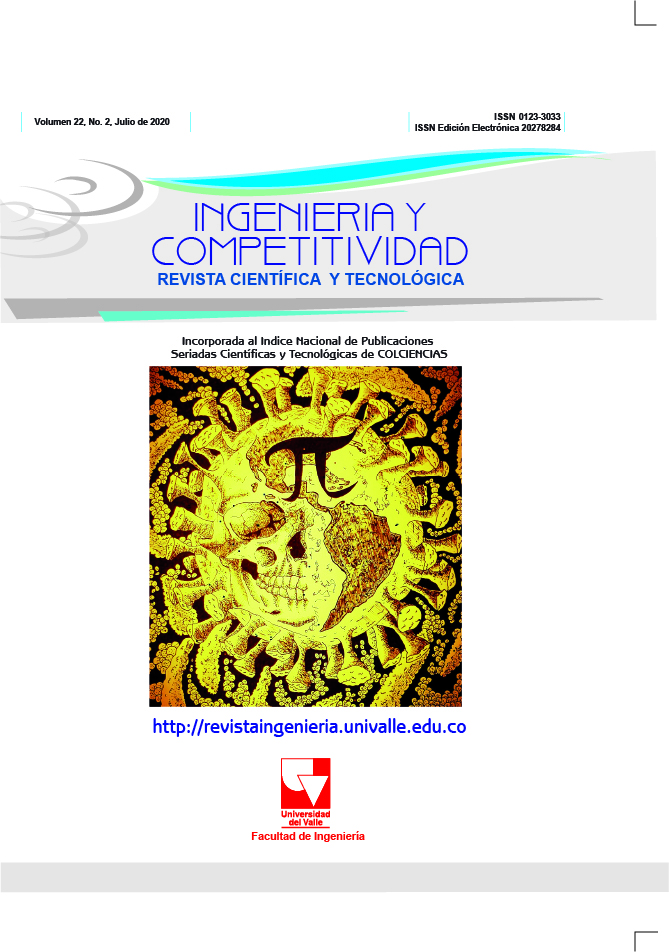Desarrollo de un equipo de tratamiento de agua residual de pintura de construcción mediante electrocoagulación
Contenido principal del artículo
El presente artículo, describe los ensayos realizados para evaluar la eficiencia del proceso de tratamiento de agua mediante electrocoagulación en agua residual de pintura de construcción. El proceso de electrocoagulación consiste en un reactor electrolítico, dotado de una fuente de corriente y electrodos encargados de aportar los iones desestabilizadores de partículas coloidales, de manera que reemplazan la función de los compuestos químicos que se utilizan en el tratamiento convencional de agua residual. Para el diseño experimental, se utiliza agua potable y pintura de pared, con el fin de someter la solución a tratamiento de electrocoagulación en una planta de tratamiento a escala, con la finalidad de hacer la comparación de los resultados antes y después del tratamiento, las variables a medir son: oxígeno disuelto (OD); turbidez; pH; conductividad; temperatura; demanda química de oxígeno (DQO). Después de revisar las eficiencias obtenidas, se procede a la elaboración de un equipo de tratamiento que permita tratar el agua de lavado de brochas y rodillos para reutilizarse nuevamente en el lavado y evitar de esta manera la contaminación ocasionada por el lavado de brochas y rodillos al pintar superficies en los procesos de construcción.
- Electrocoagulation
- Electrolysis
- Industrial Wastewater Treatment
(1) Aguilar E. Efficiency’s evaluation of an electrocoagulation cell at scale laboratory for water treatment. Rev. del Instituto de Investigación (RIIGEO) FIGMMG-UNMS. 2015; 18(35): 69-73. Doi: 10.15381/iigeo.v18i35.11843.
(2) Ruiz AA. La electrocoagulación: una alternativa para el tratamiento de aguas residuales. Revista Lasallista de investigación. 2005; 2(1): 49-56.
(3) Niño GEA, Barrera CAC, García AB, Lumbaque EC. Electrocoagulation as an efficient treatment for the removal of heavy metals from wastewater. Revista Facultad de Ciencias Básicas. 2013; 9(2): 306-317.
(4) Verma SK, Khandegar V, Saroha AK. Removal of chromium from electroplating industry effluent using electrocoagulation. Journal of Hazardous, Toxic, and Radioactive Waste. 2013; 17(2): 146-152. Doi: 10.1061/(ASCE)HZ.2153-5515.0000170.
(5) Bibiana N, Posada M, Eunice G, Niño A, Posada NBM, Niño GEA. Electrocoagulation system as treatment of galvanic wastewater. Ciencia e ingeniería Neogranadina. 2010; 20(1): 33-44. Doi: 10.18359/rcin.282.
(6) Cañizares P, Martínez F, Sáez C, Rodrigo M. The electrocoagulation, an alternative to the conventional coagulation process of wastewater. Afinidad. 2009; 66(539):27-37.
(7) Arias-Cepeda WG. Remoción de Cromo (III) y DQO a través de electrocoagulación en aguas residuales de la industria curtiembre haciendo uso racional de laenergía [master’s thesis]. Bogotá: Universidad Libre de Colombia; 2013.
(8) Diaz JJF, Aguado AEE, Martinez JA. Treatment of wastewater from chemical origin by electrocoagulation. Avances: Investigación en Ingeniería. 2014; 11(1): 65-69. Doi: 10.18041/1794-4953/avances.1.332.
(9) Vaca MCG, Ubaque CAG, Solórzano JSP. Exploratory study of dye wastewater treatment through the electrocoagulation/electroflotation method. Tecnura. 2016; 20(47): 107-117. Doi: 10.14483/udistrital.jour.tecnura.2016.1.a09.
(10) Mendoza AG, Guamán M, Pacheco CA. (2016). Aplicación del principio de electrocoagulación en el tratamiento del agua residual textil. DELOS: Desarrollo Local Sostenible. 2016; 9(26): 10.
Descargas

Esta obra está bajo una licencia internacional Creative Commons Atribución-NoComercial-CompartirIgual 4.0.
Los autores que publican en esta revista están de acuerdo con los siguientes términos:
Los autores ceden los derechos patrimoniales a la revista y a la Universidad del Valle sobre los manuscritos aceptados, pero podrán hacer los reusos que consideren pertinentes por motivos profesionales, educativos, académicos o científicos, de acuerdo con los términos de la licencia que otorga la revista a todos sus artículos.
Los artículos serán publicados bajo la licencia Creative Commons 4.0 BY-NC-SA (de atribución, no comercial, sin obras derivadas).





